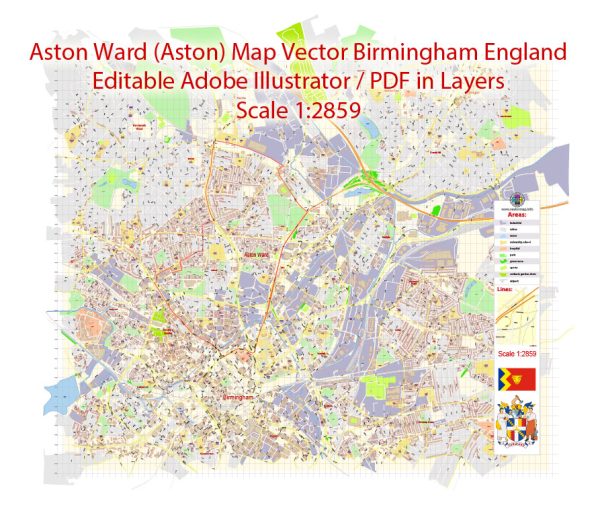The Aston Ward in Birmingham, UK, has a rich history of urban development that reflects the city’s growth and transformation over the centuries. Here is a description of the history of urban development in the Aston Ward:
- Medieval Origins: The area that now comprises Aston Ward has medieval origins, with the Domesday Book of 1086 mentioning “Estone” (Aston) as a small settlement. During this time, it was primarily agricultural land.
- Industrial Revolution: The 18th and 19th centuries saw the rapid industrialization of Birmingham, and Aston became an important part of this transformation. The construction of canals, including the Birmingham and Fazeley Canal, and the arrival of the railway helped to connect the area to the broader industrial network.
- Victorian Era: In the Victorian era, Aston continued to grow and develop. The area saw the construction of numerous factories, warehouses, and housing to accommodate the increasing population drawn to Birmingham for work in the booming industries, particularly metalworking and manufacturing.
- Housing Development: Aston experienced significant housing development during the late 19th and early 20th centuries. Rows of terraced houses and later council housing were built to provide accommodation for the working-class population. The area saw the construction of new roads and improved infrastructure to meet the demands of the growing city.
- Aston Hall: Aston Hall, a Jacobean-style mansion built in the early 17th century, stands as a historical landmark in the area. It has been preserved as a museum and reflects the grandeur of the past.
- Post-War Period: After World War II, there was a focus on rebuilding and modernizing the city. This period saw the construction of new housing estates, such as the Aston Estate, to address the housing shortage. Aston University was also established during this time.
- Modern Redevelopment: In more recent years, Aston has undergone various redevelopment projects aimed at rejuvenating the area. This includes efforts to improve housing, infrastructure, and public spaces.
- Cultural and Sporting Venues: Aston is home to several cultural and sporting venues, including Villa Park, the historic football stadium of Aston Villa Football Club. This stadium is an integral part of the community and has witnessed many historic sporting events.
- Demographic Changes: Over time, the demographic composition of Aston Ward has evolved, with a diverse population representing various cultural backgrounds and ethnicities.
- Challenges and Opportunities: Like many urban areas, Aston faces both challenges and opportunities. Economic disparities, housing issues, and urban regeneration efforts are ongoing discussions in the area.
Aston Ward’s history of urban development reflects the broader transformation of Birmingham from a small medieval settlement to a major industrial and cultural city. It showcases the city’s ability to adapt and grow over the centuries while facing various challenges and changes.


 Author: Kirill Shrayber, Ph.D.
Author: Kirill Shrayber, Ph.D.